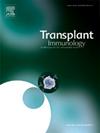Impact of anti-HLA antibodies screening techniques on waiting time on the waiting list and kidney transplant outcomes
IF 1.4
4区 医学
Q4 IMMUNOLOGY
引用次数: 0
Abstract
Background
Differences in sensitivity and specificity between the techniques used for the detection of anti-HLA antibodies before kidney transplantation (KT) can lead to contradictory results that influence patients' management. Our aim is to analyse whether the technique used, based on complement-mediated-cytotoxicity (CDC) or on microsphere fluorimetry (xMAP), conditions the waiting time until transplantation and its results.
Methods
We performed a retrospective cohort study of the KT performed in our centre from 2006 to 2018 whose pre-transplant anti-HLA specificity determination and definition of prohibited antigens was performed by CDC (2006–2011) or by xMAP (2012–2018). Living donor KT recipients were excluded. The influence of each technique on the time on the waiting list and on the outcome of kidney transplantation was analysed, using as indicators the initial function of the graft, the rate of humoral rejection and graft survival.
Results
During the period of the study, 622 patients were included (264 were studied by CDC and 358 by xMAP). Recipient and donor age was higher in the xMAP group (p < 0.001). Additionally, most sensitised patients were in the xMAP group (p < 0.001). However, they received a KT earlier. There were no differences in the rate of acute humoral rejection between groups. Nevertheless, graft survival was better in the xMAP group.
Conclusions
The introduction of the xMAP technique in our centre has meant an improvement in terms of accessibility to transplantation and the initial management of the patient. However, it does not ameliorate the indicators of graft rejection.
hla抗体筛选技术对肾移植候诊时间和结果的影响
在肾移植(KT)前检测抗hla抗体的技术之间的敏感性和特异性差异可能导致相互矛盾的结果,从而影响患者的管理。我们的目的是分析所使用的基于补体介导的细胞毒性(CDC)或微球荧光法(xMAP)的技术是否限制了移植的等待时间及其结果。方法对2006 - 2018年在我院进行移植前抗hla特异性测定和禁用抗原定义的KT患者进行回顾性队列研究,这些患者分别由CDC(2006 - 2011)或xMAP(2012-2018)进行移植前抗hla特异性测定和禁用抗原定义。活体供体KT受体被排除在外。以移植物的初始功能、体液排斥率和移植物存活率为指标,分析每种技术对肾移植等待时间和结果的影响。结果共纳入622例患者(CDC研究264例,xMAP研究358例)。受体和供体年龄在xMAP组较高(p <;0.001)。此外,大多数敏感患者在xMAP组(p <;0.001)。然而,他们在早些时候收到了KT。两组间急性体液性排斥反应发生率无差异。然而,xMAP组的移植物存活率更高。结论本中心引进xMAP技术,在移植的可及性和患者的初始管理方面有了改善。然而,它并没有改善移植排斥反应的指标。
本文章由计算机程序翻译,如有差异,请以英文原文为准。
求助全文
约1分钟内获得全文
求助全文
来源期刊

Transplant immunology
医学-免疫学
CiteScore
2.10
自引率
13.30%
发文量
198
审稿时长
48 days
期刊介绍:
Transplant Immunology will publish up-to-date information on all aspects of the broad field it encompasses. The journal will be directed at (basic) scientists, tissue typers, transplant physicians and surgeons, and research and data on all immunological aspects of organ-, tissue- and (haematopoietic) stem cell transplantation are of potential interest to the readers of Transplant Immunology. Original papers, Review articles and Hypotheses will be considered for publication and submitted manuscripts will be rapidly peer-reviewed and published. They will be judged on the basis of scientific merit, originality, timeliness and quality.
 求助内容:
求助内容: 应助结果提醒方式:
应助结果提醒方式:


